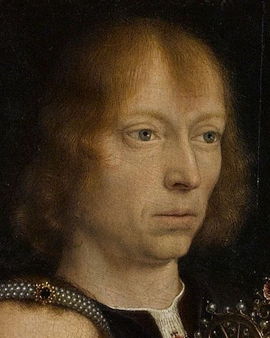Jan van Eyck is considered one of the pioneers of the Renaissance in Flanders and the Netherlands. He managed to overcome the ideas of medieval art and develop a pictorial form that prioritized realistic detail depictions. Van Eyck relied on innovative lighting and preferred motifs from nature. Contemporary artists bowed before his great talent and his precise depictions and emulated him. Gerard David belonged to the admirers of art and found in Jan van Eyck his great role model. Few data are known about David's biography. His birthplace is near Gouda and his first art lessons were probably given by Gerard's father. Towards the end of the 15th century Gerard David left and moved to Bruges. He became a member of the local guild and in a short time the young painter was highly respected. Marriage to the daughter of the head of the goldsmith's shop allowed the artist access to the upper social class of the city. Gerard David led a well-balanced financially carefree artist's life. The painter received lucrative commissions and lived for art. Historians most likely assume that the artist traveled. Gerard found inspiration in the magnificent altarpieces and religious artifacts of Italian places of worship.
As esteemed as the artist was during his lifetime, Gerard David quickly fell into obscurity after his passing in 1523. Today, David is considered the last great 15th-century painter produced by the painters' guild in Bruges. His work is a retrospective of traditional realism. The artistic work shows a clear reference to his models. Gerard David combines the idea of an unadorned depiction of the world with a restrained use of colour, achieving atmospheric scenes. The artist painted each object with a devoted attention to detail. Little things that do not immediately catch the viewer's attention, but are an invitation to go on a journey of discovery. The artist, who fell into oblivion at an early age, is now highly regarded by art historians for his technical skill and talent for giving his works a mystical expression.
David developed a special connection to religion. Only in a few exceptions does the artist refrain from using a religious theme as a motif. Only a small number of works are known from his oeuvre in which he devoted himself to portraiture. Between his creative phase and the appreciation of the Old Netherlandish painter lies a large time span. There is a possibility that the artist produced works with other motifs that were lost through warfare and ageing. The intensity with which Gerard David painted religious scenes is unusual for the Dutch Renaissance. The work speaks of a great affinity with faith. As a wealthy artist, he financially supported various religious communities and provided altarpieces.
×





.jpg)
.jpg)
.jpg)
.jpg)
.jpg)
.jpg)
_-_(MeisterDrucke-1660121).jpg)
_-_(MeisterDrucke-1660121).jpg)
_-_(MeisterDrucke-1660156).jpg)
_-_(MeisterDrucke-1660156).jpg)
_-_(MeisterDrucke-1653110).jpg)
_-_(MeisterDrucke-1653110).jpg)
.jpg)
.jpg)
_on_the_cross_Painting_by_Gerard_David_(_-_(MeisterDrucke-969840).jpg)
_on_the_cross_Painting_by_Gerard_David_(_-_(MeisterDrucke-969840).jpg)
.jpg)
.jpg)
.jpg)
.jpg)
_-_(MeisterDrucke-1463291).jpg)
_-_(MeisterDrucke-1463291).jpg)
.jpg)
.jpg)
_-_(MeisterDrucke-908657).jpg)
_-_(MeisterDrucke-908657).jpg)
_condamne_-_(MeisterDrucke-1323116).jpg)
_condamne_-_(MeisterDrucke-1323116).jpg)
.jpg)
.jpg)
.jpg)
.jpg)
.jpg)
.jpg)
.jpg)
.jpg)
_-_(MeisterDrucke-1660123).jpg)
_-_(MeisterDrucke-1660123).jpg)
_-_(MeisterDrucke-1002070).jpg)
_-_(MeisterDrucke-1002070).jpg)
.jpg)
.jpg)
.jpg)
.jpg)
.jpg)
.jpg)
 - (MeisterDrucke-135165).jpg)
 - (MeisterDrucke-135165).jpg)
.jpg)
.jpg)
_-_(MeisterDrucke-1660103).jpg)
_-_(MeisterDrucke-1660103).jpg)
.jpg)
.jpg)
.jpg)
.jpg)
 - (MeisterDrucke-138112).jpg)
 - (MeisterDrucke-138112).jpg)
.jpg)
.jpg)
.jpg)
.jpg)
.jpg)
.jpg)
.jpg)
.jpg)
.jpg)
.jpg)
.jpg)
.jpg)
_-_(MeisterDrucke-1660104).jpg)
_-_(MeisterDrucke-1660104).jpg)
_-_(MeisterDrucke-1440709).jpg)
_-_(MeisterDrucke-1440709).jpg)
.jpg)
.jpg)
.jpg)
.jpg)
.jpg)
.jpg)
.jpg)
.jpg)
 - (MeisterDrucke-60658).jpg)
 - (MeisterDrucke-60658).jpg)
.jpg)
.jpg)
.jpg)
.jpg)
.jpg)
.jpg)
.jpg)
.jpg)
.jpg)
.jpg)
.jpg)
.jpg)
.jpg)
.jpg)
.jpg)
.jpg)
.jpg)
.jpg)
 - (MeisterDrucke-102094).jpg)
 - (MeisterDrucke-102094).jpg)
.jpg)
.jpg)
.jpg)
.jpg)
.jpg)
.jpg)
.jpg)
.jpg)
.jpg)
.jpg)
.jpg)
.jpg)
.jpg)
.jpg)
.jpg)
.jpg)
.jpg)
.jpg)
.jpg)
.jpg)
.jpg)
.jpg)
.jpg)
.jpg)
.jpg)
.jpg)
.jpg)
.jpg)
.jpg)
.jpg)
.jpg)
.jpg)
.jpg)
.jpg)
.jpg)
.jpg)
.jpg)
.jpg)
.jpg)
.jpg)
.jpg)
.jpg)
.jpg)
.jpg)
 - (MeisterDrucke-76364).jpg)
 - (MeisterDrucke-76364).jpg)
.jpg)
.jpg)
.jpg)
.jpg)
.jpg)
.jpg)
.jpg)
.jpg)
.jpg)
.jpg)
.jpg)
.jpg)
.jpg)
.jpg)
.jpg)
.jpg)
.jpg)
.jpg)
.jpg)
.jpg)
.jpg)
.jpg)
.jpg)
.jpg)
.jpg)
.jpg)
_Madrid_Musee_Lazaro_Galdia_-_(MeisterDrucke-1029468).jpg)
_Madrid_Musee_Lazaro_Galdia_-_(MeisterDrucke-1029468).jpg)
_-_(MeisterDrucke-1441152).jpg)
_-_(MeisterDrucke-1441152).jpg)
.jpg)
.jpg)
.jpg)
.jpg)
.jpg)
.jpg)
_-_(MeisterDrucke-1440229).jpg)
_-_(MeisterDrucke-1440229).jpg)
.jpg)
.jpg)
.jpg)
.jpg)
.jpg)
.jpg)
.jpg)
.jpg)
.jpg)
.jpg)
_Adoration_of_the_-_(MeisterDrucke-1562910).jpg)
_Adoration_of_the_-_(MeisterDrucke-1562910).jpg)






